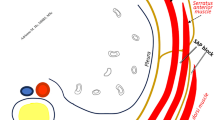Abstract
Study Design
Randomized controlled trial.
Objectives
The aim of this prospective randomized clinical trial was to compare low (0.5 μg/kg/h) and high (2.5 μg/kg/h) dose naloxone infusion on the time to tolerate liquids and meals after surgery, patient-controlled analgesia (PCA) opioid requirements, nausea and pruritus ratings, and hospital length of stay.
Summary of Background Data
Adolescents undergoing posterior spinal fusion often receive PCA after surgery and may experience common opioid-associated side effects, including nausea and pruritus. Low-dose naloxone infusion has been shown to reduce the incidence of pruritus and nausea while preserving analgesia, although an ideal dose has not been determined. Less is known about the potential for naloxone to improve bowel function after surgery.
Methods
Eighty-four patients (age 10–21 years) were randomly allocated to receive low- or high-dose naloxone infusion postoperatively. Surgical anesthetic consisted of propofol and opioid infusion with intrathecal morphine (10–15 μg/kg) at the conclusion of surgery. A visual analog scale (VAS) was used to rate nausea and pruritus.
Results
The groups had similar time to oral liquid intake after surgery and transition from PCA to oral pain medication. The VAS scores for pruritus and nausea were also similar, as was the need to treat these side effects. Morphine equivalents were similar between groups on postoperative day (POD) 0 and 1. On POD 2, the high-dose infusion group had significantly greater PCA bolus use (1.41±0.9 vs. 1.04±0.6; p<.05), although pain scores did not differ significantly. Hospital length of stay was similar for the two groups.
Conclusion
High-dose naloxone infusion was associated with similar rates of opioid side effects as low-dose. Increased PCA use noted on POD 2 may represent partial reversal of opioid analgesia in the high-dose naloxone group.
Level of Evidence
Level 1.
Similar content being viewed by others
References
Maxwell LG, Kaufmann SC, Bitzer S, et al. The effects of a smalldose naloxone infusion on opioid-induced side effects and analgesia in children and adolescents treated with intravenous patient-controlled analgesia: a double blind, prospective, randomized, controlled study. Anesth Analg 2005;100:953–8.
Gan TJ, Ginsberg B, Glass PS, et al. Opioid-sparing effects of a low-dose infusion of naloxone in patient-administered morphine sulfate. Anesthesiology 1997;87:1075–81.
Vrchoticky T. Naloxone for the treatment of narcotic induced pruritus. J Pediatr Pharm Pract 2000;5:92–7.
Carreon LY, Puno RM, Lenke LG, et al. Non-neurologic complications following surgery for adolescent idiopathic scoliosis. J Bone Joint Surg Am 2007;89:2427–32.
Seo HJ, Kim HJ, Ro YJ, Yang HS. Non-neurologic complications following surgery for scoliosis. Korean J Anesthesiol 2013;64:40–6.
Culpepper-Morgan JA, Inturrisi CE, Portenoy RK, et al. Treatment opioid-induced constipation with oral naloxone: a pilot study. Clin Pharmacol Ther 1992;52:90–5.
Liu M, Wittbrodt E. Low-dose oral naloxone reverses opioid-induced constipation and analgesia. J Pain Symptom Manage 2002;23:48–53.
Viscusi ER, Gan TJ, Leslie JB, et al. Peripherally acting mu-opioid receptor antagonists and postoperative ileus: mechanisms of action and clinical applicability. Anesth Analg 2009;108:1811–22.
O’Hara Jr JF, Cywinski JB, Tetzlaff JE, et al. The effect of epidural vs intravenous analgesia for posterior spinal fusion surgery. Paediatr Anaesth 2004;14:1009–15.
Cassady Jr JF, Lederhaas G, Cancel DD, et al. A randomized comparison of the effects of continuous thoracic epidural analgesia and intravenous patient-controlled analgesia after posterior spinal fusion in adolescents. Reg Anesth Pain Med 2000;25:246–53.
Monitto CL, Kost-Byerly S, White E, et al. The optimal dose of prophylactic intravenous naloxone in ameliorating opioid-induced side effects in children receiving intravenous patient-controlled analgesia morphine for moderate to severe pain: a dose finding study. Anesth Analg 2011;113:834–42.
Zeinali F, Stulberg JJ, Delaney CP. Pharmacological management of postoperative ileus. Can J Surg 2009;52:153–7.
Author information
Authors and Affiliations
Corresponding author
Additional information
Author disclosures: BJP (none), JTA (none), NP (none), LMA (none), RMS (none).
This study was approved by the IRB of Children’s Mercy-Kansas City.
No funding sources were utilized.
Rights and permissions
About this article
Cite this article
Pieters, B.J., Anderson, J.T., Price, N. et al. Low-Dose Versus High-Dose Postoperative Naloxone Infusion Combined With Patient-Controlled Analgesia for Adolescent Idiopathic Scoliosis Surgery: A Randomized Controlled Trial. Spine Deform 6, 430–434 (2018). https://doi.org/10.1016/j.jspd.2018.01.005
Received:
Revised:
Accepted:
Published:
Issue Date:
DOI: https://doi.org/10.1016/j.jspd.2018.01.005




